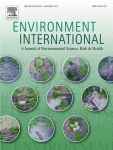Environment International 47
Overview of new articles on POPs in a new issue of the Environment International journal.

Pages 8-16
Akifumi Eguchi, Kei Nomiyama, Gnanasekaran Devanathan, Annamalai Subramanian, Kesav A. Bulbule, Peethambaram Parthasarathy, Shin Takahashi, Shinsuke Tanabe
- Analysis of levels of PCBs, PBDEs, and their metabolites in serum of Indians.
- Profiles of chlorinated and brominated compound differed between study populations.
- High PCB, 3Br BPh, 4Br OH-PBDE, and MeO-PBDE levels suggest high fish consumption.
- High 8Br- and 9Br-PBDE, 8Br-OH-PBDE, and 4Br-BPh levels indicate e-waste exposure.
Pages 23-27
Dudsadee Muenhor, Stuart Harrad
- Where and when dust is sampled in a house can influence PBDE levels substantially.
- Levels in an area close to putative sources exceeded markedly those in an area two metres away.
- Substantial variation in PBDE levels exists between different rooms in the same house.
Pages 48-55
Dorothea F.K. Rawn, J. Jake Ryan, Amy R. Sadler, Wing-Fung Sun, Douglas Haines, Kristin Macey, Jay Van Oostdam
- We provide Canadian national serum PCB and PCDD/F concentration data.
- We examine relationships between concentrations and age/gender.
- We compare Canadian concentrations with those concentrations observed elsewhere.
Brominated and chlorinated flame retardants in San Francisco Bay sediments and wildlife
Pages 56-65
Susan L. Klosterhaus, Heather M. Stapleton, Mark J. La Guardia, Denise J. Greig
- PBDEs detected at high concentrations in San Francisco Bay wildlife samples.
- HBCDs, DP, PBEB, and BTBPE were also detected.
- The alternative flame retardants were detected at much lower concentrations than PBDEs.
- Elevated concentrations near highly urbanized areas.
- First measurement of PBDE alternatives in a highly urbanized North American estuary.
Hydroxylated and methoxylated polybrominated diphenyl ethers in blood plasma of humans in Hong Kong
Pages 66-72
Hong-Sheng Wang, Zhuo-Jia Chen, Ka-Lok Ho, Li-Chen Ge, Jun Du, Michael Hon-Wah Lam, John P. Giesy, Ming-Hung Wong, Chris Kong-Chu Wong
Highlights
- 7 MeO-BDEs, 15 OH-BDEs and 3 bromophenols were analyzed in 116 plasma samples.
- 3-MeO-BDE-47, 6-OH-BDE-47 and 2, 4, 5-TBP were their corresponding predominant congeners.
- Accumulation of organo-brominated compounds are from inter-conversion.
- Patterns of relative concentrations of the target analytes were similar in fish diet.
Background exposure to persistent organic pollutants predicts stroke in the elderly
Pages 115-120
Duk-Hee Lee, P. Monica Lind, David R. Jacobs, Samira Salihovic, Bert van Bavel, Lars Lind
- POPs have recently emerged as a new risk factor for cardiovascular diseases.
- Organochlorine pesticides predicted the future risk of stroke in elderly.
- PCBs predicted the future risk of stroke in elderly.
Pages 121-130
K. Jakobsson, J. Fång, M. Athanasiadou, A. Rignell-Hydbom, Å. Bergman
- Low, moderately and highly brominated PBDEs were present in umbilical cord serum.
- Low to moderately brominated PBDEs enrich in colostrum compared to maternal serum.
- Levels of BDE‐153 and BDE‐209 are lower in mature milk than in colostrum.
- The reporting of study designs and results should be improved, to enable comparisons.
26.7.2012




